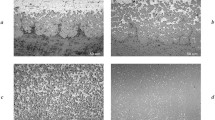Abstract
The effect of the solvent metal on the composition of titanium oxides formed at the interface of a Ti-containing melt with Al2O3 was analyzed. The fact that titanium in dilute solution is oxidized to a higher degree than in the pure form is thermodynamically connected with the bond energy between the solvent metal and aluminum transferred from the alumina to the melt. Recommendations for controlling the oxygen concentration of the reaction products are given.
Similar content being viewed by others
References
R. Bondley, “Metal—ceramic seals,” Electronics,20, No. 7, 97 (1947).
Yu. V. Haidich and V. S. Zhuravlev, “Adhesion, wettability, and interaction of titanium-containing melts with refractory oxides,” Ogneupory, No. 1, 50–55 (1974).
A. Metcalf (ed.), Interfaces in Metallic Composites, Vol. 1 [Russian translation], Mir, Moscow (1978).
M. G. Nicholas, T. M. Valentine, and M. J. Wite, “The wetting of alumina with copper alloyed with titanium and other elements,” J. Mater. Sci.,15, 2197–2206 (1980).
C. Wan, P. Kritsalis, B. Drevet, and N. Eustathopoulos, “Optimization of wettability and adhesion in reactive nickel-brazed alloy alumina systems by a thermodynamic approach,” Materials Sci. and Engineering (a), 181–186 (1996).
P. Xiao and B. Derby, “Wetting of TiNx by liquid metals and alloys,” Proc. Int. Conf. High Temp. Capillarity, Smolenice Castle, 80–84 (1994).
I. I. Kornilov and V. V. Glazova, “On the physicochemical nature of alloys in the Ti−Al−O system,” Tr. 6th Soveshchanie po Metallokhimiya Titana, Novye Issledovaniya Titanovykh Splavov, Nauka, Moscow (1965), pp. 3–10.
V. N. Batygin, A. M. Reshetnikov, and I. I. Metelkin, Vacuum-Dense Ceramics and their Soldering with Metals [in Russian], Énergiya, Moscow (1973).
Yu. V. Naidich, V. S. Zhuravlev, V. G. Chuprina, and L. V. Strashinskaya, “Adhesion, wettability, and the formation of intermediate phases in titanium-containing melt-oxide systems. Communication 1,” Poroshk. Metall., No. 11, 40–46 (1973).
P. Kritsalis, L. Coudurier, and N. Eustathopoulos, “Contribution to the study of reactive wetting in the CuTi/Al2O3 system,” J. Mater. Sci.,26, 3400–3408 (1991).
M. Paulasto and J. Kivilahti, “Microstructural study of Al2O3/Ti joints brazed with different Ag−Cu filler metals,” Ceramic Transactions,35, 165–174 (1993).
Yu. V. Naidich, V. S. Zhuravlev, and V. G. Chuprina, “Adhesion, wetting, and the formation of intermediate phases in titanium-containing melt-oxide systems. Communication 2,” Poroshk. Metall., No. 3, 82–85 (1974).
P. Kritsalis, B. Drevet, N. Valignat, and N. Eustathopoulos, Spectra Metall. Mater.,30, 1127 (1994).
I. V. Nikolenko, G. I. Batalin, E. A. Beloborodova, et al., “Enthalpy of solution of titanium in Pb−Ti melts,” Zh. Fiz. Khim.,58, No. 11, 2866–2867 (1984).
I. V. Nikolenko, G. I. Batalin, E. A. Beloborodova, et al., “Enthalpy of solution of titanium in gallium-titanium and indium-titanium melts,” ibid.,59, No. 3, 728–730 (1985).
V. I. Nikolaenko, E. A. Beloborodova, G. I. Batalin, and V. S. Zhuravlev, “Enthalpy of mixing of titanium in Sn−Ti melts,” ibid.,58, No. 11, 2873–2876 (1984).
G. I. Batalin, E. A. Beloborodova, V. V. Norubashchenko, and A. N. Shlapak, “Heat of solution of titanium, zirconium, and boron in liquid aluminum,” Izv. Akad. Nauk. SSSR, Metally, No. 1, 69–71 (1981).
M. G. Valishev, Enthalpy of Formation of Liquid Binary Alloys Based on Titanium and Vanadium. Avtoref. Dis. Kand. Fiz.-Mat. Nauk., Sverdlovsk (1984).
Yu. O. Esin, M. G. Valishev, A. F. Ermakov, et al., “Enthalpy of formation of liquid alloys of germanium and nickel with titanium,” Zh. Fiz. Khim.,55, No. 3, 753–754 (1981).
V. A. Grigoryan, L. N. Belyanchikov, and A. Ya. Stomakhin, Theoretical Principles of Steel Electromelting Processes [in Russian], Metallurgiya, Moscow (1987).
M. A. Turchanin and I. V. Nikolaenko, “Enthalpies of solution of titanium, zirconium, and hafnium in liquid copper,” J. Alloys and Compounds, 236–242 (1996).
A. R. Miedema, F. R. deBoer, R. Room, and J. W. F. Dorleign, Calphad1, 353 (1977).
J. L. Murray, “The Au−Ti system,” Bull. of Alloy Phase Diagrams,4, No. 3, 278–283 (1983).
G. I. Batalin, E. A. Beloborodova, and V. P. Kazimirov, Thermodynamics and Constitution of Liquid Alloys Based on Aluminum [in Russian], Metallurgiya, Moscow (1983).
M. E. Es'kov, R. A. Vecher, and V. V. Samokhval, “Investigation of the thermodynamic properties of Al−Ni and Al−Pd alloys,” in: Thermodynamic Properties of Metallic Alloys [in Russian], Élektronika, Baku (1975), pp. 267–269.
S. T. Rostovtsev, Theory of Metallurgical Processes [in Russian], Moscow (1956).
I. S. Kulikov, Thermal Dissociation of Compounds [in Russian], Metallurgiya, Moscow (1969).
D. I. Ryzhanov, Theory of Metallurgical Processes [in Russian], Metallurgiya, Moscow (1989).
Additional information
Institute for Materials Science Problems, Ukrainian Academy of Sciences, Kiev. Donbas State Mechanical Engineering Academy, Kramatorsk. Translated from Poroshkovaya Metallurgiya, Nos. 3–4, pp. 27–33, March–April, 1997.
Rights and permissions
About this article
Cite this article
Zhuravlev, V.S., Turchanin, M.A. Reasons for the formation of various titanium oxide phases upon wetting aluminum oxide with titanium-containing metallic solutions. Powder Metall Met Ceram 36, 141–146 (1997). https://doi.org/10.1007/BF02676078
Issue Date:
DOI: https://doi.org/10.1007/BF02676078




